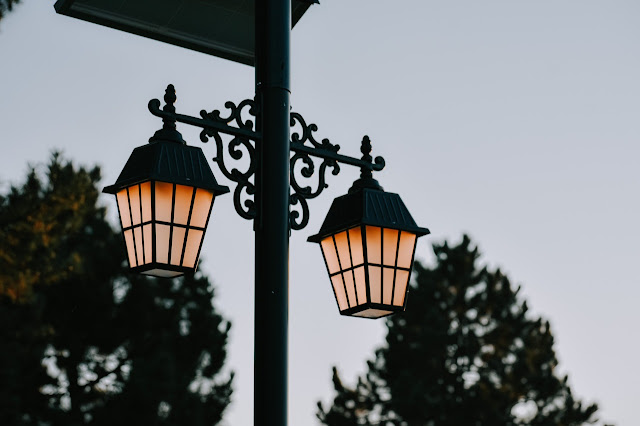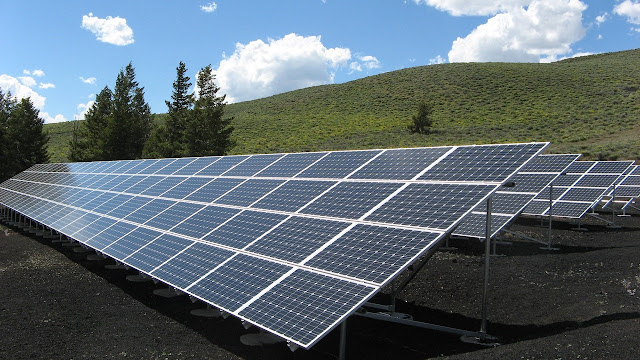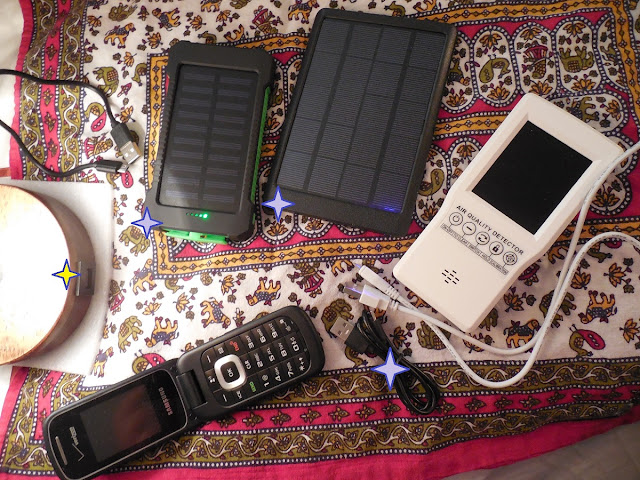Common Problems with Outdoor Solar Lights
You can find many solar devices on Amazon now. But most are only useful if you put them in the sunniest place in your yard. This assumes you have a yard. Or a porch with full sunlight for at least four hours a day (some devices demand 6-8). Such perfect expectations are the reason solar devices haven't taken hold. People who are interested buy a few devices, find out they don't work well, and stop buying. There are also some limitations such as, if the device is very small, it can't have a lithium battery. Therefore, it will only work in the summer when freezing temperatures won't disable the battery.
Whole house solar power, and emergency solar generators don't have this issue because, presumably you can put the battery compartment indoors while they charge, and leave only the solar panels outside in the cold. But miniature devices, such as lights that require no wiring, must operate in outdoor temperature ranges.
Because these items are not very popular and aren't often discussed in mainstream magazines, I suspect manufacturers aren't aware that they're selling instant junk. While I can believe that there is some desire to scam people in any marketplace, the sheer number of different devices which are in the "instant junk" category (in my opinion), says that the manufacturers aren't receiving any feedback from customers.
Let's change that with a few examples.
Example 1 - Tiny solar path lights - far too dim to do help with nighttime safety, will turn off as soon as the temperature goes below freezing, the cheap price doesn't make up for these flaws - hackable, but not hackable enough to fix the freezing temperature problem. In that video, it's upgraded from a NiCd battery to a NiMH battery, which doesn't solve much except it makes it last longer, the upgrade in brightness is due to the upgrade in inductor. A lithium battery would not even fit inside. These are at best decorative and for summer use only.
Example 2 - Far too many LEDs for one battery - At least they put a lithium battery in this one. If you have a place that gets full sunlight for hours every day, then you can use this. Otherwise, this will be fully drained of power within an hour or two after dusk. You'll have problems if it's rainy for several days in a row though. Also it's incredibly ugly, why would I want that on my house? I guess if I was going for a robotic look on my home, but otherwise, no. This falls into the same category.
Example 3 - Fairy lights - I happen to know from experience that 800mAh is a common storage amount for NiMH batteries and Lithium batteries. But in this case it's NiMH. I bought something similar to this, but I looked at this because it said "upgraded." Well maybe it was upgraded from NiCd, because I know a Lithium battery won't fit into those little rectangles. And even if it did, it might be too much voltage. I would need to modify the control board and that's pushing hacking a bit too far for me. The upshot is, the fairy lights won't work indoors because, no sun. Won't work outdoors, because, they turn off in freezing weather. So they only work in the summer. Ho-hum.
The basic idea, and why hacking is common
The basic concept of solar lights designed for outdoor use, is, there's a solar panel that collects light and turns it into electric current (usually 5V). But since, you want light when it's dark out, they have to store the energy in a battery and give it back to you at night. The most efficient light "bulb" right now is an LED, which has a voltage minimum before it lights up. Actually it flashes at a very high speed instead of glowing like a regular incandescent light bulb. As a result, it doesn't lose much energy to heat. This also means that if you open a device, and it has a 3.7V battery, it probably won't work with a lower voltage battery. More on hacking devices later.
So LEDs are used so the battery will last as long as possible. Batteries have storage capacities measured in milli-Amps per hour, or mAh. For an outdoor light that will last all night, it's really pushing it to expect 800 mAh to last all night, but some designs try that. most good designs have at least 2200 mAh or multiple batteries to store the solar energy, so they will last. Since there are many iffy designs out there, many enthusiasts have taken to hacking them to make them better. The easiest hack is just to upgrade the battery. Be careful to match the voltage if you do this.
In addition, the more LEDs, the more drain on the battery, and thus the larger the mAh the design should have. Most devices I've seen are chronically underpowered now, and assume absurd amounts of sunlight, such as 8 hours of direct sunlight per day. Instead of storing more energy, or providing a larger PV panel, the design makes assumptions that put onerous limits on use. This drives people to hack the devices or avoid them.
Most people can at least hack the battery to be larger, as long as the casing is large enough to hold the larger battery. More advanced hacks change the circuit board or "logic" in the device. Youtube is full of how to's and with some effort, anyone can learn the basics.
 |
Lumens
Pay attention to the lumens. There's a lot to learn when you're first buying solar lights. Kelvin, Voltage, mAh, lumens. But the first consideration is how many lumens it gives you. The spotlight mentioned in Example 2, it says "up to 200 lumens" for 6-10 hours on a full charge. That's already a deception. We know that it has a high and low mode. The low mode lasts for 10 hours on a full charge, but we're only told the lumens of the high mode. And 200 lumens is less than half the lumens of a 40 watt incandescent bulb. That's not nothing, but it's really small. Underpowered outdoor lights are giving solar power a very bad name.
The price of solar lights is tied directly to the number of lumens provided. So when you shop for them, the cheap junk shows up first, probably due to shopping algorithms that assume how much you are willing to pay. In this case, shopping algorithms are hurting an industry, because it's actually very hard to find a high lumens solar light. Go ahead and try finding one. You keep getting redirected, like a lost child, to the junk. If you don't know what to look for, or what brand, you can get the idea that high lumens don't exist for solar lights.
And indeed, high lumens solar lights are rare. Part of the reason is that it takes a lot more battery storage and much more photovoltaic (PV) to run more LEDs all night long, and then recharge the next day. The lights need to be larger. So some of the brightest lights you can get are post lights, where bulky isn't so noticeable. Here's an example. Merely 300 lumens, yet nearly $300. One dollar per lumen. That's if you want style. If you're ok with ugly, there's this. However, I wouldn't bet on that light lasting all night. The company is in Florida, I doubt if they've stress tested it in Vermont, or even North Carolina.
Since adequate lumens = safety at night, I don't think solar lights will catch on until a reliable outdoor light is found. It's even currently considered "for commercial use" to have a light that has an adequate design to last all night and be reliable in cold weather. As if home owners don't need reliability. Really?
Battery Types
For a while, battery types were changing, and NiCd batteries were used extensively for rechargeable things. However, they had a problem with "memory" if you remember, you had to charge your device all the way, and then let it discharge all the way, and repeat. If you charged it every day, like we do now, with lithium batteries, you'd have a battery that didn't last as long, and you'd have to charge/discharge it a few times to get it back to normal. If it's even possible. We call it a memory effect, but it's really a polarity effect. These days we've switched to NiMH batteries mostly, since this memory effect isn't so obvious with them. However, it can still happen, and NiMH and NiCd, both don't work if the temperatures are below zero. Differences between NiCd and NiMH FAQ here.
Since we're talking about outdoor lights, neither of the Nickel batteries helps. They both stop working at 0°C, or when water freezes. Lithium batteries extend this to -20°C or -4°F. This still doesn't help much. A lot of the US gets much colder than that during the winter at night. And at night is when you need light. Tonight's temperature in Durham, NC will be 24°F which is enough to turn off any Nickel based solar lights. And it will stay that way for another month or two. Lithium is good here. But it wouldn't work in Vermont or Maine.
Batteries need a way to keep warm, and lights need to be designed to keep from freezing the batteries at night. Maybe an LED needs to be inside the battery compartment. They don't give off much heat, but they give off a little. Maybe it's enough. When you have lights that include over 100 LEDs, they can spare one to keep the battery from freezing, can't they? This is a design issue that "needs fixed" before these devices can be mainstream.
Note that buying batteries on Amazon is impossible. I've made complaints about it already, they don't seem too concerned and don't even understand battery types enough to evaluate bad advertising, at this point. The pictures conflict with the descriptions in nearly every case, and the choices to narrow results are not remotely helpful. You're better off using a specialty battery store. A good way to evaluate a battery store is how easily you can find 18650 and 14500 batteries in it. Examples:
https://www.batterymart.com/c-18650-rechargeable-batteries.html
https://www.batteryjunction.com/liion-cat.html
Anything good out there?
Well actually yes. I did find a few items that have some promise. Not having infinite money I only bought one of them, but I did test it in freezing weather and in a place that only gets afternoon sun, and it works great. The trick is to place it just below eye level so it doesn't blind someone when it gets brighter.
Motion sensing lights are usually brighter when they sense motion, this is because they save the battery charge for when someone is nearby. Since these things are small, they can't really be "on" all night at full brightness. So they stay dim, so people can navigate toward them, and when they get close enough, they brighten up.
Be careful when you take a picture of it, I saw many pictures of solar lights that were in "customer comments" and made them look bright. But they aren't. What I had to do was switch the camera mode to "landscape at night" and some cameras may lack such a setting.
Here's how bright it looks if I just point and click the camera, while the iThird is in low-light mode:
Here's the reality. Notice the second light near the step? I like having two lights, that one is weaker, but also reliable. At this early point in time, I like a little redundancy built into the system:
That's while the light is just on low, waiting for someone to come near and trigger the motion sensor. Now when it's on high after the motion sensor is triggered:
Here's the view from farther away:
I can't say it's "pretty" but it does the job and avoids the overly robotic look of some of the lights I see out there. You can read by it, perfectly well, you can see the stair and walk, and the house number. And best of all, I haven't seen the iThird light fail yet. For an affordable and reliable light, it's the best I've found so far.
I also like the post lights, but they are fairly expensive if you want a nice one. It's in my budget, but will be part of a future upgrade to my home.
Others I should mention are the ones that are handmade in Indiana. And some people on etsy make such beautiful things simply for the joy of it.
Lots of hackable-good if you are willing
There are path lights that actually shed usable light and come with lithium batteries. The batteries have very small storage though, and they run down quickly. They won't last all night without hacking them. But they are already running on 3.7V so they're a good candidate for someone who wants to tinker with it. They have 5 LEDs, and they look dim, but it's enough to see if there's a step up, or a crack in the pavement. For a cheap thrill or something to tinker with, these are a good bet. Here's a case where an 800mAh battery is Lithium. The voltage tells you it's lithium, and the code 14500.
That's not very much storage. No wonder it turns off before the night is through. To upgrade this, you'd have to do some soldering. You could buy an 18650 type Lithium battery which has much more mAh storage, and thus would last all night, and have the same voltage. There's a size difference though, and it won't fit into the same battery compartment. You'd have to find a way to affix the new battery safely, and connect it without causing any shorts. A good beginner project. Just keep in mind that the solar panel is always ON. There is no way to turn it off, keep it flat on the table, upside down while working, or ZAP!
To end on a positive note, I don't want to give the impression that it's all bad news. As long as "industrial" is the style you're going for, there is a distributor in the US that collects good candidates for outdoor LED solar lighting: https://www.superiorlighting.com/led-fixtures/solar-light-fixtures/ Most of their stock is not underpowered and has decent design. However, the style isn't something I really want all around my house. Great ideas for office buildings though. This one has some good options, but many are underpowered. But they do look good, and for style, they want a lot more money. Isn't that always the case?
And finally my favorite reason to look into these devices. If there's a power outage, they're far better than candles, just go outside and bring them in to use them, place them back outside during the day to charge up. Even a cheap item works for this. It might be junk, but keep it charged up. Power outages do happen.
Explainer video shows how solar lights work. Gives a detailed electronics explanation:







